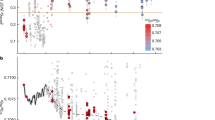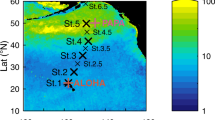Abstract
Inorganic carbon measurements made in the late 1980s suggest that alkalinity in the waters surrounding the Hawaiian Archipelago is elevated relative to the oligotrophic waters of the North Pacific. These observations have been interpreted as evidence for a “halo” of elevated carbonate saturation state produced by the dissolution of highly soluble magnesium calcites and aragonite on the island platform or in the water column surrounding the islands. If present, this “halo” has implications for air–sea carbon dioxide exchange in Hawaiian waters and may impact the response of coral reef communities to the acidification of the surface waters of the global ocean. The purpose of this study was to assess the magnitude and extent of the elevated calcium carbonate saturation state observed on previous expeditions to this region. Transects were conducted near several atolls in the Northwestern Hawaiian Islands from shallow water adjacent to the forereef to the open ocean 15 km from the island. Hydrographic profiles were collected at each station, and discrete water samples were collected for the measurement of carbon system parameters necessary to compute calcium carbonate saturation state. Our data were compared with observations made at the Hawaii Ocean Time-series site at Station ALOHA and with hydrographic data collected on the WOCE lines in the North Pacific around the archipelago. We did not detect a carbonate dissolution halo around the islands. We conclude that the previously observed halo was probably an analytical artifact, or possibly a result of extreme variability in carbon chemistry surrounding the islands.






Similar content being viewed by others
References
Agegian CR, Mackenzie FT (1989) Calcareous organisms and sediment mineralogy on a mid-depth bank in the Hawaiian Archipelago. Pac Sci 43(1):56–66
Agegian C, Mackenzie F, Tribble J, Sabine C (1988) Carbonate production and flux from a mid-depth ecosystem, Penguin Bank, Hawaii. In: Agegian CR (ed) Biogeochemical cycling and fluxes between the deep euphotic zone and other oceanic realms. National Undersea Research Program Research Report 88-1, NOAA, U.S. Dept. of Commerce. Washington, DC, pp 5–32
Andersson AJ, Gledhill D (2013) Ocean acidification and coral reefs: effects on breakdown, dissolution, and net ecosystem calcification. Annu Rev Mar Sci 5:1.1–1.28
Andersson AJ, Bates NR, Mackenzie FT (2007) Dissolution of carbonate sediments under rising pCO2 and ocean acidification: observations from Devil’s Hole Bermuda. Aquat Geochem 13(3):237–264
Andersson A, Mackenzie F, Bates N (2008) Life on the margin: implications of ocean acidification on Mg-calcite, high latitude and cold-water marine calcifiers. Mar Ecol Prog Ser 373:265–273
Andersson A, Kuffner I, Mackenzie F, Jokiel P, Rodgers K, Tan A (2009) Net Loss of CaCO3 from a subtropical calcifying community due to seawater acidification: mesocosm-scale experimental evidence. Biogeosciences 6:1811–1823
Andréfouët S, Pagès J, Tartinville B (2001) Water renewal time for classification of atoll lagoons in the Tuamotu Archipelago (French Polynesia). Coral Reefs 20(4):399–408
Behairy A, El-Sayed MK (1984) Carbonate cements in a modern Red Sea reef, north of Jeddah, Saudi Arabia. Mar Geol 58(3–4):443–450
Berelson W, Balch W, Najjar R, Feely R, Sabine C, Lee K (2007) Relating estimates of CaCO3 production, export, and dissolution in the water column to measurements of CaCO3 rain into sediment traps and dissolution on the sea floor: A revised global carbonate budget. Glob Biogeochem Cycles 21:GB1024. doi:10.1029/2006GB002803
Bischoff WD, Mackenzie FT, Bishop FC (1987) Stabilities of synthetic magnesian calcites in aqueous solution: comparison with biogenic materials. Geochim Cosmochim Acta 51(6):1413–1423
Caldeira K, Wickett M (2003) Anthropogenic carbon and ocean pH. Nature 425(6956):365
Chanson M, Millero F (2007) Effect of filtration on the total alkalinity of open-ocean seawater. Limnol Oceanogr Methods 5:293–295
Chave KE (1954) Aspects of the biogeochemistry of magnesium 1. Calcareous marine organisms. J Geol 62(3):266–283
Chave KE (1962) Factors influencing the mineralogy of carbonate sediments. Limnol Oceanogr 7(2):218–223
Chen C (2002) Shelf-vs. dissolution-generated alkalinity above the chemical lysocline. Deep Sea Res Part II 49(24–25):5365–5375
Clayton T, Byrne R (1993) Spectrophotometric seawater pH measurements: total hydrogen ion concentration scale calibration of m-cresol purple and at-sea results. Deep Sea Res Part I 40(10):2115–2129
Dickson AG (1990) Standard potential of the reaction: and and the standard acidity constant of the ion HSO4- in synthetic sea water from 273.15 to 318.15 K. J Chem Thermodyn 22(2):113–127
Dickson A, Afghan J, Anderson G (2003) Reference materials for oceanic CO2 analysis: a method for the certification of total alkalinity. Mar Chem 80(2–3):185–197
Dickson A, Sabine C, Christian J (eds) (2007) Guide to best practices for ocean CO2 measurements. PICES Special Publication 3, p 191
Doney S, Fabry V, Feely R, Kleypas J (2009) Ocean acidification: the other CO2 problem. Annu Rev Mar Sci 1:169–192
Feely R, Sabine C, Lee K, Berelson W, Kleypas J, Fabry V, Millero F (2004) Impact of anthropogenic CO2 on the CaCO3 system in the oceans. Science 305(5682):362–366
Firing J, Brainard RE (2006) Ten years of shipboard ADCP measurements along the northwestern Hawaiian Islands. Atoll Res Bull 543:347–363
Friedlingstein P, Houghton R, Marland G, Hackler J, Boden T, Conway T, Canadell J, Raupach M, Ciais P, Le Quèrè C (2010) Update on CO2 emissions. Nat Geosci 3(12):811–812
Gattuso J, Frankignoulle M, Bourge I, Romaine S, Buddemeier R (1998) Effect of calcium carbonate saturation of seawater on coral calcification. Global Planet Change 18(1–2):37–46
Gran G (1952) Determination of the equivalence point in potentiometric titrations. Part II. Analyst 77(920):661–671
Grigg R (1997) Paleoceanography of coral reefs in the Hawaiian-Emperor Chain-revisited. Coral Reefs 16(5):33–38
Gross MG, Milliman JD, Tracey JI Jr, Ladd HS (1969) Marine geology of Kure and Midway Atolls, Hawaii: a preliminary report. Pac Sci 23:17–25
Johnson KM, King AE, Sieburth JMN (1985) Coulometric TCO2 analyses for marine studies; an introduction. Mar Chem 16(1):61–82
Jokiel P, Rodgers K, Kuffner I, Andersson A, Cox E, Mackenzie F (2008) Ocean acidification and calcifying reef organisms: a mesocosm investigation. Coral Reefs 27(3):473–483
Kleypas J, Buddemeier R, Archer D, Gattuso J, Langdon C, Opdyke B (1999) Geochemical consequences of increased atmospheric carbon dioxide on coral reefs. Science 284(5411):118–120
Lamb M, Sabine C, Feely R, Wanninkhof R, Key R, Johnson G, Millero F, Lee K, Peng T, Kozyr A (2002) Consistency and synthesis of Pacific Ocean CO2 survey data. Deep Sea Res Part II 49:21–58
Lantz CA, Atkinson MJ, Winn CD, Kahng SE (2013) Dissolved inorganic carbon and total alkalinity of a Hawaiian fringing reef: chemical techniques for monitoring the effects of ocean acidification on coral reefs. Coral Reefs. doi:10.1007/s00338-013-1082-5
Le Quéré C, Raupach MR, Canadell JG, Marland G (2009) Trends in the sources and sinks of carbon dioxide. Nat Geosci 2:831–836
Le Quéré C, Andres RJ, Boden T, Conway T, Houghton RA, House JI, Marland G, Peters GP, van der Werf G, Ahlström A, Andrew RM, Bopp L, Canadell JG, Ciais P, Doney SC, Enright C, Friedlingstein P, Huntingford C, Jain AK, Jourdain C, Kato E, Keeling RF, Klein Goldewijk K, Levis S, Levy P, Lomas M, Poulter B, Raupach MR, Schwinger J, Sitch S, Stocker BD, Viovy N, Zaehle S, Zeng N (2012) The global carbon budget 1959–2011. Earth Syst Sci Data Discuss 5:1107–1157
Lowe RJ, Falter JL, Monismith SG, Atkinson MJ (2009) A numerical study of circulation in a coastal reef-lagoon system. J Geophys Res 114:C06022
Lueck RG, Mudge TD (1997) Topographically induced mixing around a shallow seamount. Science 276(5320):1831–1833
Mackenzie FT, Lerman A (2006) Carbon in the geobiosphere: earth’s outer shell. topics in geobiology, vol 25. Springer, Dordrecht, p 402
Mackenzie FT, Bischoff WD, Bishop FC, Loijens M, Schoonmaker J, Wollast R (1983) Magnesian calcites; low-temperature occurrence, solubility and solid-solution behavior. Rev Miner Geochem 11(1):97
Manzello DP, Kleypas JA, Budd DA, Eakin CM, Glynn PW, Langdon C (2008) Poorly cemented coral reefs of the eastern tropical Pacific: possible insights into reef development in a high-CO2 world. Proc Natl Acad Sci 105(30):10450–10455
Merrifield M, Holloway P, Johnston T (2001) The generation of internal tides at the Hawaiian Ridge. Geophys Res Lett 28(4):559–562
Millero FJ, Graham TB, Huang F, Bustos-Serrano H, Pierrot D (2006) Dissociation constants of carbonic acid in seawater as a function of salinity and temperature. Mar Chem 100(1–2):80–94
Milliman J (1993) Production and accumulation of calcium carbonate in the ocean: budget of a nonsteady state. Global Biogeochem Cycles 7(4):927–957
Milliman J, Troy P, Balch W, Adams A, Li Y, Mackenzie F (1999) Biologically mediated dissolution of calcium carbonate above the chemical lysocline? Deep Sea Res Part I 46(10):1653–1669
Morse JW, Mackenzie FT (1990) Geochemistry of sedimentary carbonates. Elsevier Science Ltd, Amsterdam, p 724
Morse JW, Zullig JJ, Bernstein LD, Millero FJ, Milne P, Mucci A, Choppin GR (1985) Chemistry of calcium carbonate-rich shallow water sediments in the Bahamas. Am J Sci 285(2):147–185
Morse J, Andersson A, Mackenzie F (2006) Initial responses of carbonate-rich shelf sediments to rising atmospheric pCO2 and ocean acidification: role of high Mg-calcites. Geochim Cosmochim Acta 70(23):5814–5830
Orr J, Fabry V, Aumont O, Bopp L, Doney S, Feely R, Gnanadesikan A, Gruber N, Ishida A, Joos F, Key R, Lindsay K, Maier-Reimer E, Matear R, Monfray P, Mouchet A, Najjar R, Plattner G-K, Rodgers K, Sabine C, Sarmiento J, Schlitzer R, Slater R, Totterdell I, Weirig M-F, Yamanaka Y, Yool A (2005) Anthropogenic ocean acidification over the twenty-first century and its impact on calcifying organisms. Nature 437(7059):681–686
Pagès J, Andréfouët S, Delesalle B, Prasil V (2001) Hydrology and trophic state in Takapoto Atoll lagoon: comparison with other Tuamotu lagoons. Aquat Living Resour 14:183–193
Pierrot D, Lewis E, Wallace D (2006) MS Excel program developed for CO2 system calculations. ORNL/CDIAC-105 Carbon Dioxide Information Analysis Center, Oak Ridge National Laboratory, US Department of Energy, Oak Ridge, Tennessee
Ridgwell A, Hargreaves J (2007) Regulation of atmospheric CO2 by deep-sea sediments in an Earth system model. Global Biogeochemical Cycles 21(2):GB2008. doi:10.1029/2006GB002764
Riebesell U, Zondervan I, Rost B, Tortell P, Zeebe R, Morel F (2000) Reduced calcification of marine plankton in response to increased atmospheric CO2. Nature 407(6802):364–367
Rudnick D, Boyd T, Brainard R, Carter G, Egbert G, Gregg M, Holloway P, Klymak J, Kunze E, Lee C (2003) From tides to mixing along the Hawaiian Ridge. Science 301(5631):355–357
Sabine C (1992) Geochemistry of particulate and dissolved inorganic carbon in the central North Pacific [unpublished Ph.D. thesis]. University of Hawaii, Honolulu, HI
Sabine C, Mackenzie F (1995) Bank-derived carbonate sediment transport and dissolution in the Hawaiian Archipelago. Aquat Geochem 1(2):189–230
Sabine C, Feely R, Gruber N, Key R, Lee K, Bullister J, Wanninkhof R, Wong C, Wallace D, Tilbrook B (2004) The oceanic sink for anthropogenic CO2. Science 305(5682):367–371
Schlanger S, Konishi K (1975) The geographic boundary between the coral-algal and the bryozoan-algal limestone facies: a paleolatitude indicator. 9th Int Congr Sedimentol 1:187–190
Silverman J, Lazar B, Erez J (2007) Effect of aragonite saturation, temperature, and nutrients on the community calcification rate of a coral reef. J Geophys Res 112(C5):C05004
Smith SV, Kimmerer WJ, Laws EA, Brock R, Walsh TW (1981) Kaneohe Bay sewage diversion experiment: perspectives on ecosystem responses to nutritional perturbation. Pac Sci 35(4):279–395
Acknowledgments
This work was funded by NOAA’s Office of National Marine Sanctuaries, through the Papahānaumokuākea Marine National Monument. We would like to thank our colleagues Coulson Lantz, Andreas Andersson, Fred Mackenzie, and Marlin Atkinson for technical assistance and for many fruitful discussions. We would also like to thank Sarah Davis and Caitlin Miles for assistance with collection and analysis of samples.
Author information
Authors and Affiliations
Corresponding author
Rights and permissions
About this article
Cite this article
Thompson, R.W., Dickson, A.G., Kahng, S.E. et al. Nearshore Carbonate Dissolution in the Hawaiian Archipelago?. Aquat Geochem 20, 467–481 (2014). https://doi.org/10.1007/s10498-014-9230-2
Received:
Accepted:
Published:
Issue Date:
DOI: https://doi.org/10.1007/s10498-014-9230-2




